Abstract
The effects of pyrazinoate and nicotinate on urate transport in microvillus membrane vesicles isolated from canine renal cortex were evaluated. An outwardly directed gradient of pyrazinoate stimulated uphill urate accumulation, suggesting urate-pyrazinoate exchange. An inside-alkaline pH gradient stimulated uphill pyrazinoate accumulation, which suggested pyrazinoate-OH- exchange. Pyrazinoate-OH- exchange and urate-OH- exchange were similarly sensitive to inhibitors, implying that both processes occur via the same transport system. In addition, an inward Na+ gradient stimulated uphill pyrazinoate accumulation, suggesting Na+-pyrazinoate cotransport. Inhibitor studies demonstrated that Na+-pyrazinoate cotransport takes place via the same pathway that mediates Na+-lactate cotransport in these membrane vesicles. Previously we found that urate does not share this Na+-dependent cotransport pathway. Nicotinate inhibited transport of pyrazinoate by the anion exchange pathway and the Na+ cotransport pathway, suggesting that it is a substrate for both transport systems. Finally, in the presence of an inward Na+ gradient, low doses of pyrazinoate or nicotinate stimulated urate uptake, and higher doses of pyrazinoate or nicotinate inhibited urate accumulation, thereby mimicking in vitro the paradoxical effects of drugs on renal urate excretion that have been observed in vivo. These findings indicate that the paradoxical effect of uricosuric drugs at low doses to cause urate retention may result at least in part from stimulation of urate reabsorption across the luminal membrane of the proximal tubular cell.
Full text
PDF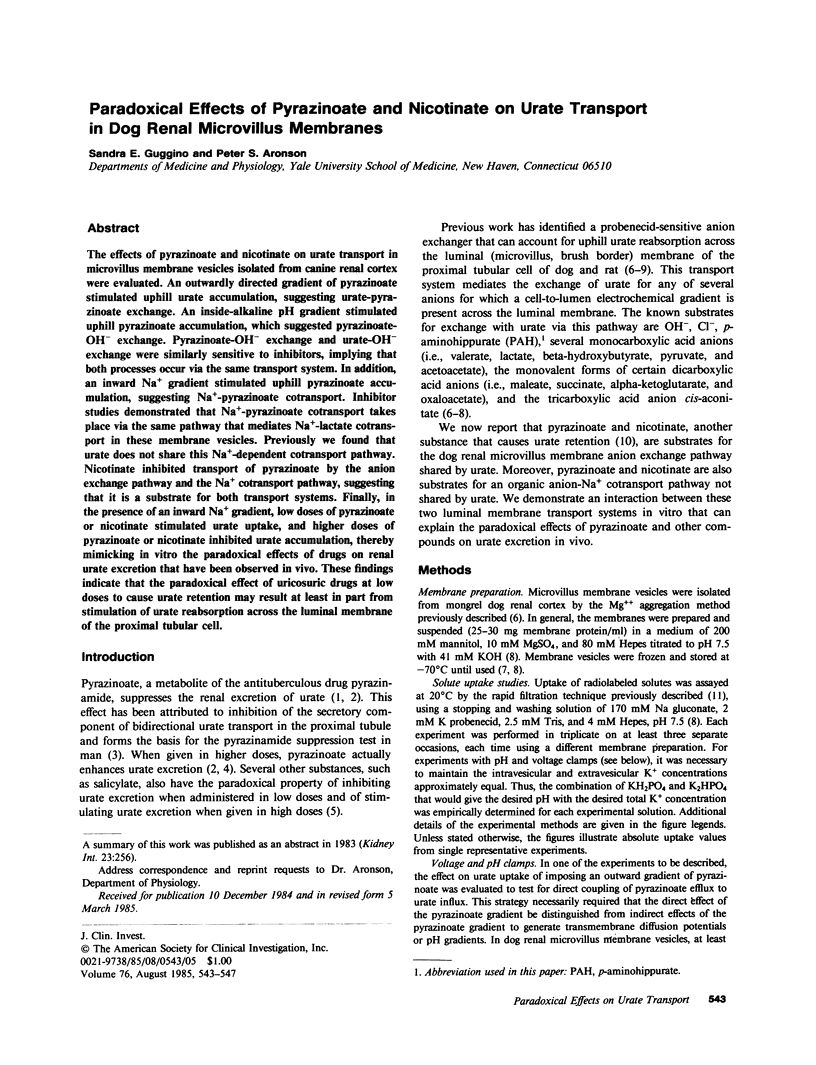
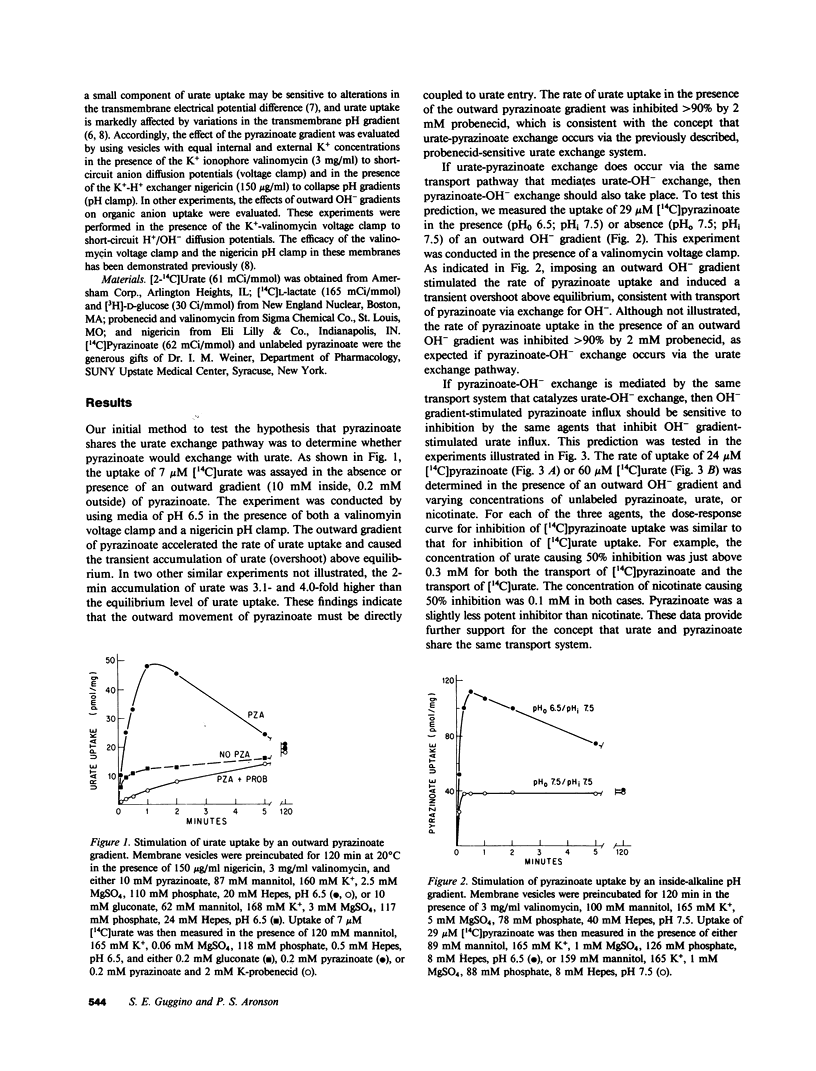
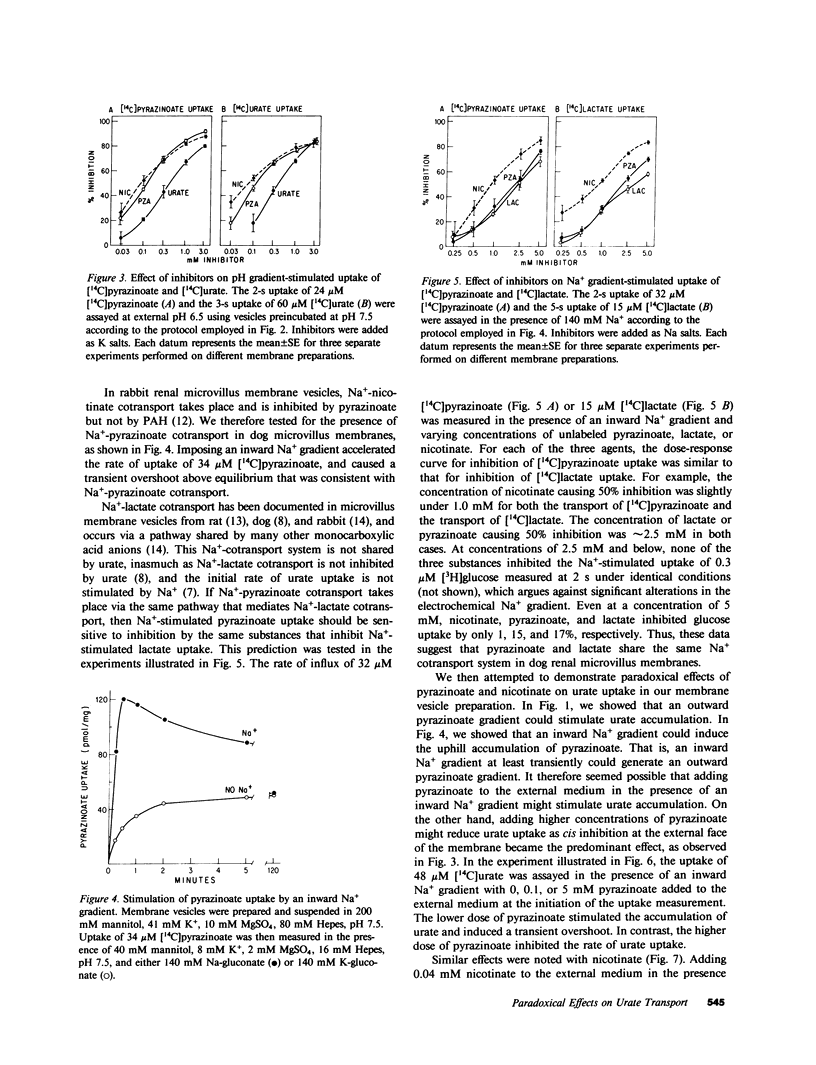
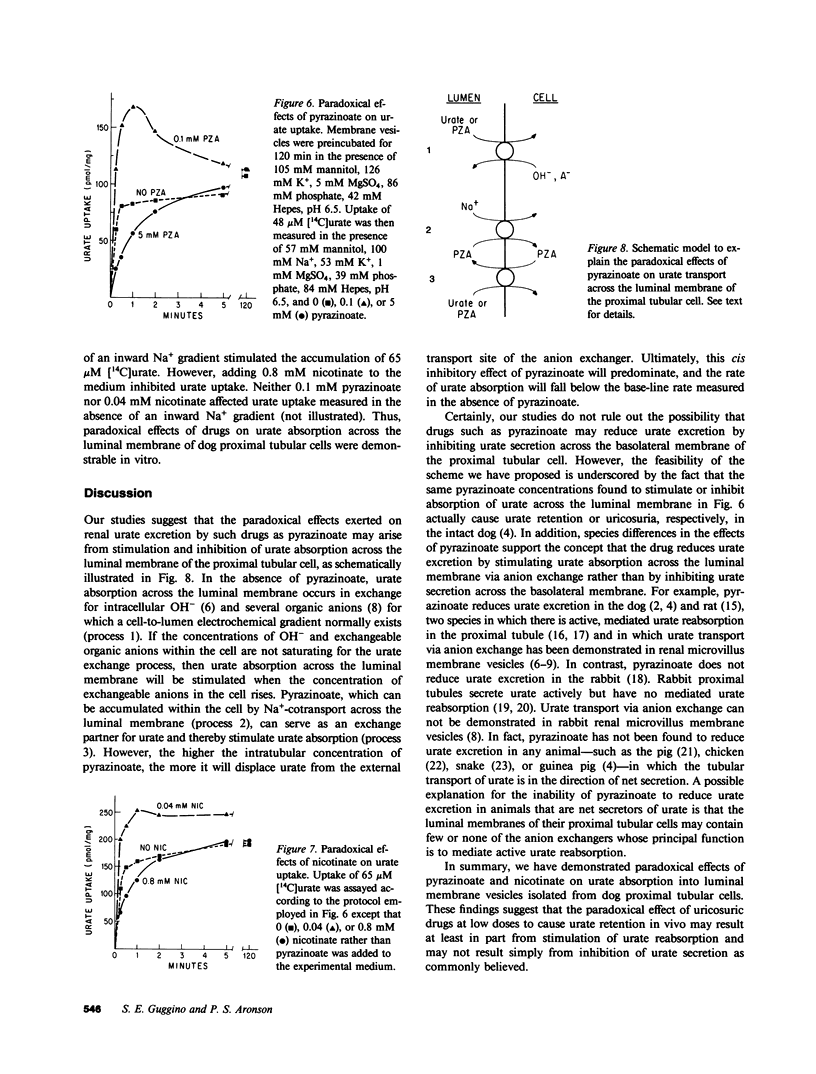
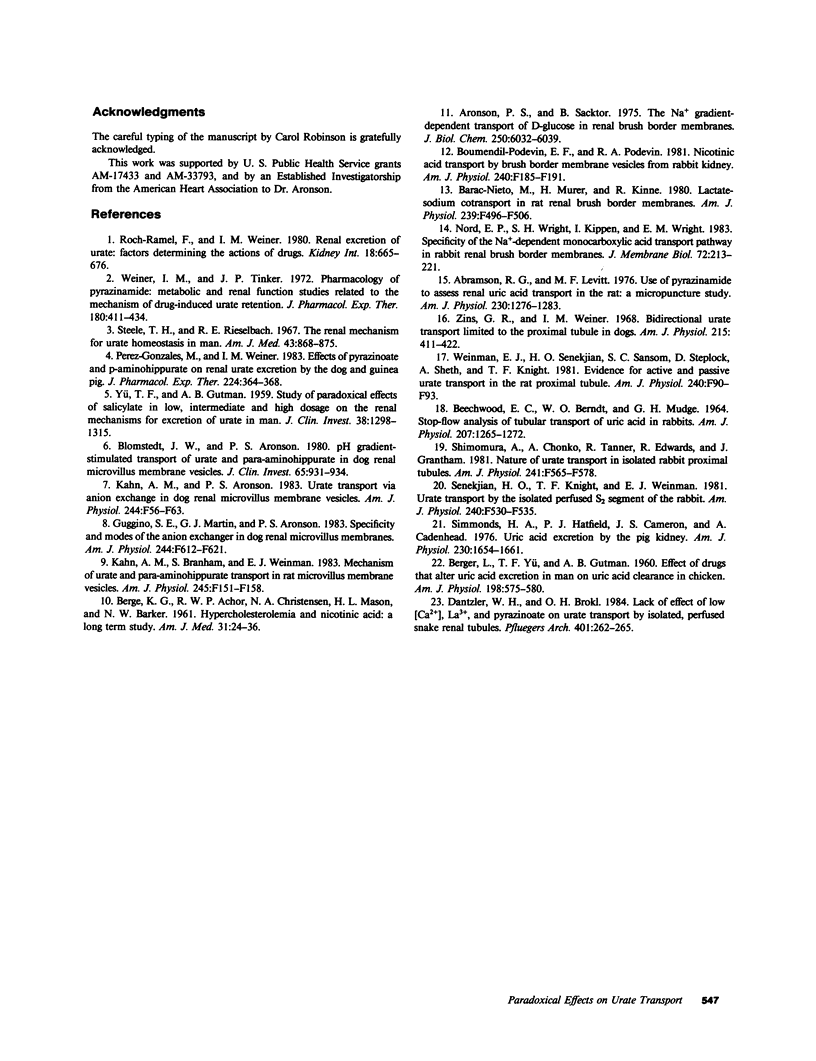
Selected References
These references are in PubMed. This may not be the complete list of references from this article.
- Abramson R. G., Levitt M. F. Use of pyrazinamide to assess renal uric acid transport in the rat: a micropuncture study. Am J Physiol. 1976 May;230(5):1276–1283. doi: 10.1152/ajplegacy.1976.230.5.1276. [DOI] [PubMed] [Google Scholar]
- Aronson P. S., Sacktor B. The Na+ gradient-dependent transport of D-glucose in renal brush border membranes. J Biol Chem. 1975 Aug 10;250(15):6032–6039. [PubMed] [Google Scholar]
- BEECHWOOD E. C., BERNDT W. O., MUDGE G. H. STOP-FLOW ANALYSIS OF TUBULAR TRANSPORT OF URIC ACID IN RABBITS. Am J Physiol. 1964 Dec;207:1265–1272. doi: 10.1152/ajplegacy.1964.207.6.1265. [DOI] [PubMed] [Google Scholar]
- BERGER L., YU T. F., GUTMAN A. B. Effect of drugs that alter uric acid excretion in man on uric acid clearance in the chicken. Am J Physiol. 1960 Mar;198:575–580. doi: 10.1152/ajplegacy.1960.198.3.575. [DOI] [PubMed] [Google Scholar]
- Barac-Nieto M., Murer H., Kinne R. Lactate-sodium cotransport in rat renal brush border membranes. Am J Physiol. 1980 Nov;239(5):F496–F506. doi: 10.1152/ajprenal.1980.239.5.F496. [DOI] [PubMed] [Google Scholar]
- Blomstedt J. W., Aronson P. S. pH gradient-stimulated transport of urate and p-aminohippurate in dog renal microvillus membrane vesicles. J Clin Invest. 1980 Apr;65(4):931–934. doi: 10.1172/JCI109748. [DOI] [PMC free article] [PubMed] [Google Scholar]
- Boumendil-Podevin E. F., Podevin R. A. Nicotinic acid transport by brush border membrane vesicles from rabbit kidney. Am J Physiol. 1981 Mar;240(3):F185–F191. doi: 10.1152/ajprenal.1981.240.3.F185. [DOI] [PubMed] [Google Scholar]
- Dantzler W. H., Brokl O. H. Lack of effect of low [Ca2+], La3+, and pyrazinoate on urate transport by isolated, perfused snake renal tubules. Pflugers Arch. 1984 Jul;401(3):262–265. doi: 10.1007/BF00582593. [DOI] [PubMed] [Google Scholar]
- Guggino S. E., Martin G. J., Aronson P. S. Specificity and modes of the anion exchanger in dog renal microvillus membranes. Am J Physiol. 1983 Jun;244(6):F612–F621. doi: 10.1152/ajprenal.1983.244.6.F612. [DOI] [PubMed] [Google Scholar]
- Kahn A. M., Aronson P. S. Urate transport via anion exchange in dog renal microvillus membrane vesicles. Am J Physiol. 1983 Jan;244(1):F56–F63. doi: 10.1152/ajprenal.1983.244.1.F56. [DOI] [PubMed] [Google Scholar]
- Kahn A. M., Branham S., Weinman E. J. Mechanism of urate and p-aminohippurate transport in rat renal microvillus membrane vesicles. Am J Physiol. 1983 Aug;245(2):F151–F158. doi: 10.1152/ajprenal.1983.245.2.F151. [DOI] [PubMed] [Google Scholar]
- Nord E. P., Wright S. H., Kippen I., Wright E. M. Specificity of the Na+-dependent monocarboxylic acid transport pathway in rabbit renal brush border membranes. J Membr Biol. 1983;72(3):213–221. doi: 10.1007/BF01870588. [DOI] [PubMed] [Google Scholar]
- Perez-Gonzalez M., Weiner I. M. Effects of pyrazinoate and p-aminohippurate on renal urate excretion by the dog and guinea pig. J Pharmacol Exp Ther. 1983 Feb;224(2):364–368. [PubMed] [Google Scholar]
- Roch-Ramel F., Weiner I. M. Renal excretion of urate: factors determining the actions of drugs. Kidney Int. 1980 Nov;18(5):665–676. doi: 10.1038/ki.1980.184. [DOI] [PubMed] [Google Scholar]
- Senekjian H. O., Knight T. F., Weinman E. J. Urate transport by the isolated perfused S2 segment of the rabbit. Am J Physiol. 1981 Jun;240(6):F530–F535. doi: 10.1152/ajprenal.1981.240.6.F530. [DOI] [PubMed] [Google Scholar]
- Shimomura A., Chonko A., Tanner R., Edwards R., Grantham J. Nature of urate transport in isolated rabbit proximal tubules. Am J Physiol. 1981 Nov;241(5):F565–F578. doi: 10.1152/ajprenal.1981.241.5.F565. [DOI] [PubMed] [Google Scholar]
- Simmonds H. A., Hatfield P. J., Cameron J. S., Cadenhead A. Uric acid excretion by the pig kidney. Am J Physiol. 1976 Jun;230(6):1654–1661. doi: 10.1152/ajplegacy.1976.230.6.1654. [DOI] [PubMed] [Google Scholar]
- Steele T. H., Rieselbach R. E. The renal mechanism for urate homeostasis in normal man. Am J Med. 1967 Dec;43(6):868–875. doi: 10.1016/0002-9343(67)90245-8. [DOI] [PubMed] [Google Scholar]
- Weiner I. M., Tinker J. P. Pharmacology of pyrazinamide: metabolic and renal function studies related to the mechanism of drug-induced urate retention. J Pharmacol Exp Ther. 1972 Feb;180(2):411–434. [PubMed] [Google Scholar]
- Weinman E. J., Senekjian H. O., Sansom S. C., Steplock D., Sheth A., Knight T. F. Evidence for active and passive urate transport in the rat proximal tubule. Am J Physiol. 1981 Feb;240(2):F90–F93. doi: 10.1152/ajprenal.1981.240.2.F90. [DOI] [PubMed] [Google Scholar]
- YU T. F., GUTMAN A. B. Study of the paradoxical effects of salicylate in low, intermediate and high dosage on the renal mechanisms for excretion of urate in man. J Clin Invest. 1959 Aug;38(8):1298–1315. doi: 10.1172/JCI103905. [DOI] [PMC free article] [PubMed] [Google Scholar]
- Zins G. R., Weiner I. M. Bidirectional urate transport limited to the proximal tubule in dogs. Am J Physiol. 1968 Aug;215(2):411–422. doi: 10.1152/ajplegacy.1968.215.2.411. [DOI] [PubMed] [Google Scholar]


